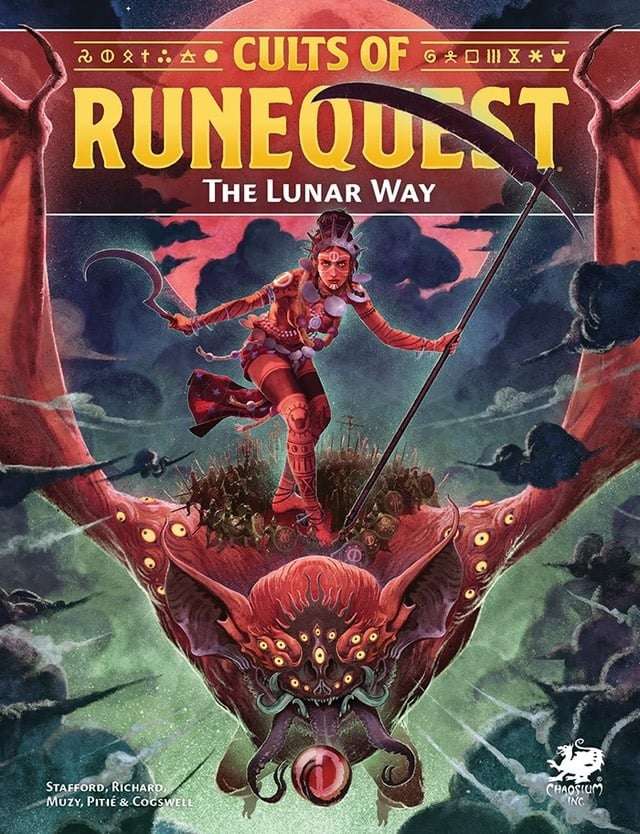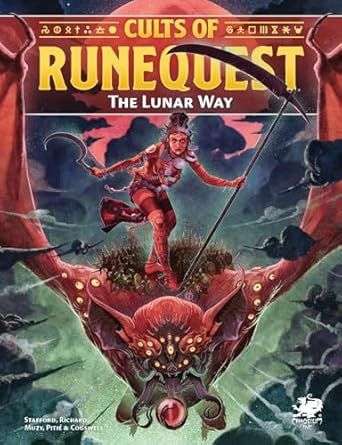
For all things fantasy, horror, and speculative fiction

Review Details
Review type: Book
Title: Cults of RuneQuest: The Lunar Way
Author: Greg Stafford
Publisher: Chaosium
Release date: 22nd May 2024

Reviewed by: Seth Stauffer
Other details: Paperback £29.81
Cults of RuneQuest: The Lunar Way by Greg Stafford
Book Review
Seth Stauffer
Glorantha is the infamous setting for the long-lasting role-playing game RuneQuest, created by the great Greg Stafford. The setting has been around for decades and is still going strong. Even though Stafford conceived it at least 40 years ago, Chaosium still produces content for this iconic world. It’s 2024, and CuIts of RuneQuest: The Lunar Way has been published, further developing an already renowned setting.
The book is written to fit The Lunar Way into the existing lore. Its place is laid out.
Early in the book, The Lunar Way is introduced as a unique mythology that complements the already-existing pantheon in Glorantha. This unique lore is designed to accompany the solar religion, adding depth and complexity to the game world.
As myths, tales, and traditions, it’s an enjoyable read. I’m a sucker for world-building, and this doesn’t disappoint. Everything is set out well. The book follows a logical progression and attempts to answer questions like, “Why am I here?” giving insightful particulars.
It’s exciting and visually impressive, with lots of eye-catching art. Bold swaths of red (blood?) appear to be splashed across the pages, and the illustrations look both alluring and horrifying. Moreover, the characters, deities, and beings represented look distinct. From cover to cover, it’s visually impressive.
Fascinating details are added to the various organizations, such as the specifics for membership. One example was the need to dedicate time to whichever organization a character was to be a member of. As appealing as this is, it also marks a divide between the gamemaster and player, but not always for great reasons.
While I loved the details and nuance throughout the text, I wondered if implementing the text as written into a game wouldn’t turn into cumbersome bookkeeping. Two examples are sacrificing magic points for holidays in the case of Irripi Ontor or the need to commit “90% of their time and 90% of their income for the cult,” as in the case of Yanafal Tarnils. Situations like these are intriguing and provide excellent specificity to the different factions enumerated in the text. The concerning part is tracking all of that. It might be simple for an individual player. Still, it could become a real slog for a gamemaster dealing with a group of players.
This is a supplement, and the content on these pages is optional for playing RuneQuest. However, this product adds depth to an already deep game. The effort to provide thorough and substantive content goes a little far, and not all gamers will care for that. This product is fantastic for people who enjoy elaborate myth and folklore and is especially recommended for RuneQuest fans.
Tags: ChaosiumFantasyRuneQuestTTRPG Review
Category: Book ReviewGame Review
All reviews
Latest Reviews:
- The Human Chord by Algernon Blackwood
- The Fog by James Herbert
- A Palace Near The Wind by Ai Jiang
- Extremity by Nicholas Binge
- Girl Dinner by Olivie Blake
- The Swan’s Daughter by Roshani Chokshi
- Out of the Past, Tales of Haunting History edited by Aaron Worth
- Witchborne by Rachel Grosvenor
- Shattered Reality . Call of Cthulhu Scenario Anthology
- The Flesh King by Richard Kadrey
Review tags:
Action (48) Adventure (69) Angry Robot Books (11) Contemporary Fantasy (15) Fantasy (116) Gothic Horror (12) Harper Voyager (12) Historical Fantasy (14) Hodderscape (11) Horror (73) Orbit Books (33) Romance (28) Science Fiction (35) Titan Books (36) TorDotCom (12)
Leave a Reply